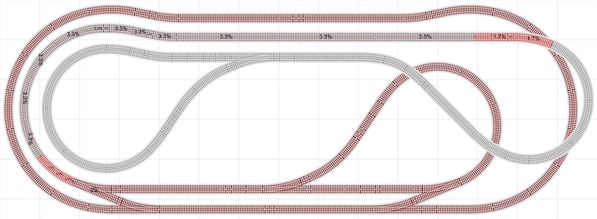Skip, here is a revision of my earlier track plan that incorporates vertical easements (inspired by another thread here on the forum). The idea is to create an easement in the change of grade, in order to avoid the sharp change in grade from 0% to 3.2% So that locomotives will have less time when a driving wheel is "lifted" above the rail for a short distance (thus reducing traction) over the track section joints. Long ridged-wheelbase steamers will have the most difficulty with sharp vertical transitions, while two-axle trucks will tend to always have all four wheels in contact with the rail head.
The short sections will gradually increase in grade when going from 0% to 3.2% (and the reverse when going from 3.2% back to 0% at the top of the grade). Theoretically, with four short sections between 0% and 3.2%, each section will change by roughly 0.64%: from 0%: 0.64%; 1.28%; 1.92%; 2.56%; 3.2%. [You would not need to be as mathematically precise as this implies, this just shows how a vertical transition works.]
Incidentally, my Lionchief Plus FT ABA set is strong at climbing grades, in addition to motors in all units driving all 12 axles, in two-axle trucks, there are traction tires on each unit, and in an un-advertised feature, all three units have strong Magnatraction on all axles (I tested, and previously reported this feature here on the forum).
One could try to bend vertically, a long section of track (like a O48 30-degree curve) to form a vertical easement. For a track system not composed of ridged plastic roadbed, of course. This would be challenging to do, but possible. Perhaps simpler in the long run to use four short track sections to build the easement as I have shown. Its even better to use long sections of track for the vertical easement, like full O72 sections, but this track plan does not allow for this wide a diameter.
There is a trade-off between the length of the vertical easements, and the grade between easements. In the plan shown, the addition of vertical easements increased the "ruling-grade" between the easements from 3.2% to 3.3%, a worthwhile trade-off in this case.
Finally, there is nothing mandated about using four sections of sectional track for a vertical easement, even a single section is an improvement over no easement, while using more than four track sections is only marginally better. Four sections was just convenient for this plan, as Lionel makes quarter-sections of O48 FasTrack curves.






